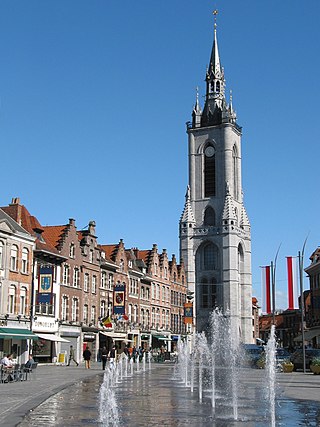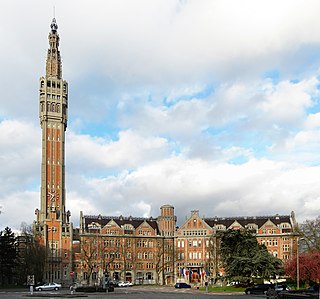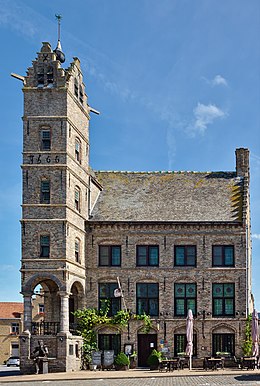
Lo-Reninge is a city and municipality located in the Belgian province of West Flanders. The municipality comprises the towns of Lo, Noordschote, Pollinkhove and Reninge. On January 1, 2006, Lo-Reninge had a total population of 3,306. The total area is 62.94 km2 which gives a population density of 53 inhabitants per km2. The Old Town Hall of Lo, built between 1565 and 1566, and its belfry were inscribed on the UNESCO World Heritage List in 1999 as part of the Belfries of Belgium and France site.

Veurne is a city and municipality in the Belgian province of West Flanders. The municipality comprises the town of Veurne proper and the settlements of Avekapelle, Booitshoeke, Bulskamp, De Moeren (Belgium), Eggewaartskapelle, Houtem, Steenkerke, Vinkem, Wulveringem, and Zoutenaaie.

Herentals is a city in the province of Antwerp. The municipality comprises the city of Herentals proper and the towns of Morkhoven and Noorderwijk. In 2022, Herentals had a total population of 28.455. The total area is 48.56 km2 (18.75 sq mi). Saint Waltrude is the patron saint of the city.

Sint-Truiden is a city and municipality located in the province of Limburg, Flemish Region, Belgium, and has over 41,500 inhabitants, which makes it one of the largest cities in Limburg. The municipality includes the former communes of Aalst, Brustem, Duras, Engelmanshoven, Gelinden, Gorsem, Groot-Gelmen, Halmaal, Kerkom-bij-Sint-Truiden, Melveren, Metsteren, Ordingen, Runkelen, Velm, Wilderen, and Zepperen.

The belfry is a structure enclosing bells for ringing as part of a building, usually as part of a bell tower or steeple. It can also refer to the entire tower or building, particularly in continental Europe for such a tower attached to a city hall or other civic building.

Lo is a place in the Belgian province of West Flanders in Belgium and a borough of the municipality Lo-Reninge. Lo is a small medieval town and the community Lo-Reninge of which it is a part obtained the city title in 1985. The Old Town Hall of Lo, built between 1565-1566, and its belfry were inscribed on the UNESCO World Heritage List in 1999 as part of the Belfries of Belgium and France site.

Lier is a municipality located in the Belgian province of Antwerp, arguably on the outskirts of Antwerp. It is composed of the city of Lier proper and the village of Koningshooikt. The city centre is surrounded by the river Nete, around which it grew. In 2018, Lier had a total population of 35,712. The total area is 49.70 km2 making a population density (PD) of 720 per km2. Lier is known for its beers, its patron saint St. Gummarus and Lierse vlaaikes cake. It is also home to the world headquarters of Van Hool, a global bus and coach manufacturer. Lier's two principal football clubs are K. Lyra-Lierse and Lierse Kempenzonen.

The Belfries of Belgium and France are a group of 56 historical buildings designated by UNESCO as World Heritage Sites, in recognition of the civic belfries serving as an architectural manifestation of emerging civic independence from feudal and religious influences in the former County of Flanders and neighbouring areas which once were possessions of the House of Burgundy.

The Cloth Hall is a large cloth hall, a medieval commercial building, in Ypres, Belgium. The original structure was erected mainly between 1200 and 1304, in the Gothic style. It was one of the largest commercial buildings of the Middle Ages, when it served as the main market and warehouse for the Flemish city's prosperous cloth industry. At 125 metres (410 ft) in breadth, with a 70 metres (230 ft)-high belfry tower, it recalls the importance and wealth of the medieval trade city.

The Belfry of Ghent is one of three medieval towers that overlook the old city centre of Ghent, Belgium; the other two belonging to Saint Bavo Cathedral and Saint Nicholas' Church. Its height of 91 metres (299 ft) makes it the tallest belfry in Belgium. The belfry of Ghent, together with its attached buildings, belongs to the set of Belfries of Belgium and France, a UNESCO World Heritage Site.

The Belfry of Tournai is a freestanding bell tower of medieval origin in Tournai, Belgium, 72 metres (236 ft) in height with a 256-step stairway. This landmark building is one of a set of Belfries of Belgium and France registered on the UNESCO World Heritage List in recognition of their civic architecture and importance in the rise of municipal power in Europe.

The Belfry of Bruges is a medieval bell tower in the centre of Bruges, Belgium. One of the city's most prominent symbols, the belfry formerly housed a treasury and the municipal archives, and served as an observation post for spotting fires and other dangers.

The City Hall of Antwerp, Belgium, stands on the western side of that city's Grote Markt. Erected between 1561 and 1565, after designs made by Cornelis Floris de Vriendt and several other architects and artists, this Renaissance building incorporates both Flemish and Italian influences. The building is listed as one of the Belfries of Belgium and France, a UNESCO World Heritage Site.

The Town Hall of Oudenaarde, East Flanders, Belgium, is a landmark building and the seat of that city. Built in a Brabantine late-Gothic style between 1526 and 1537, it is listed as one of the Belfries of Belgium and France, a UNESCO World Heritage Site.

Saint Peter's Church in Leuven, Belgium, is a Roman Catholic church built in the 15th century in the Brabantine Gothic style. The church has a cruciform floor plan and a low bell tower that has never been completed. It is 93 metres (305 ft) long. It is located on the city's Grote Markt, opposite the Town Hall. In 1999, the belfry and bell tower of the church was inscribed on the UNESCO World Heritage List as part of the Belfries of Belgium and France site, in recognition of the civil importance and architecture of the belfries in the region.

The Belfry of Kortrijk is a medieval bell tower in the historical centre of Kortrijk, Belgium. One of the city's most prominent symbols, the belfry formerly housed a treasury and the municipal archives, and served as an observation post for spotting fires and other danger. A narrow, steep staircase, accessible by the public without any entry fee, leads to the top of the building, which nowadays leans about a bit to the west. In 1999, the belfry was inscribed on the UNESCO World Heritage List as part of the Belfries of Belgium and France site, in recognition of the civil, not religious, importance and architecture of the belfries in the region.

The Hôtel de Ville is a historic building in Arras, Pas-de-Calais, northern France. It was built in the 16th century, and completed in 1517. It was restored in the 19th century, and re-dedicated on 26 August 1867 by Emperor Napoleon III. It was then almost completely destroyed in World War I and rebuilt during the 1920s, using some modern materials where practicable. This can most obviously be seen inside the tower, where the main supporting structure is concrete. It has been listed as an official national monument since 1921. In 2005, the belfry was added to the UNESCO World Heritage List as part of the Belfries of Belgium and France site because of its architecture and historical importance in maintaining municipal power in Europe.

The Hôtel de Ville is a municipal building in Lille, France. Built between 1924 and 1932 in Art Deco style of Flemish neo-Renaissance inspiration, it is listed as a Monument historique since May 2002. Its belfry is a UNESCO World Heritage Site, inscribed in 2005 along with many other Belfries of Belgium and France in recognition of its architecture and importance in the history of municipal power in Europe. The latter should not be confused with the belfry of Lille's Chamber of Commerce, also emblematic of the city.

Calais City Hall is the seat of the city council in Calais, France. It has a 72-metre belfry of red brick and white limestone.

The Grand-Place is the main square and the centre of activity of Tournai, Hainaut, Belgium. The square has a triangular shape, owing it to the convergence of several ancient paths, and it covers 7,500 m2 (81,000 sq ft).




















